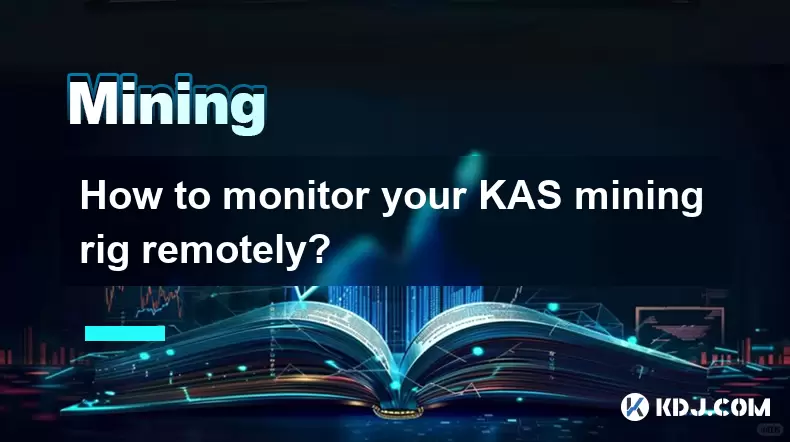-
 bitcoin
bitcoin $121833.232455 USD
-0.63% -
 ethereum
ethereum $4394.437030 USD
-2.00% -
 tether
tether $1.000570 USD
0.04% -
 bnb
bnb $1255.553465 USD
-3.73% -
 xrp
xrp $2.814944 USD
-1.59% -
 solana
solana $221.835346 USD
-2.40% -
 usd-coin
usd-coin $0.999869 USD
0.01% -
 dogecoin
dogecoin $0.249495 USD
-1.32% -
 tron
tron $0.336905 USD
-1.24% -
 cardano
cardano $0.816464 USD
-1.69% -
 chainlink
chainlink $22.130946 USD
-1.27% -
 hyperliquid
hyperliquid $44.208522 USD
-3.46% -
 ethena-usde
ethena-usde $1.000521 USD
0.02% -
 sui
sui $3.422897 USD
-2.51% -
 stellar
stellar $0.380164 USD
-1.31%
How to monitor your KAS mining rig remotely?
Remotely monitor your KAS mining rig using tools like HiveOS or Minerstat to track hash rate, temperature, and uptime in real time.
Jul 24, 2025 at 09:28 am

Understanding Remote Monitoring for KAS Mining Rigs
Monitoring your KAS (Kaspa) mining rig remotely allows you to keep track of performance, temperature, hash rate, and uptime without being physically present. This is essential for maintaining efficiency and detecting issues early. Remote monitoring ensures that your mining operation runs smoothly even when you're away from your setup. The process involves installing software tools that transmit data from your rig to a cloud service or personal dashboard accessible via the internet. To begin, ensure your mining rig runs a stable operating system like Windows, Linux, or HiveOS, all of which support remote access and monitoring tools.
Setting Up Your Mining Rig for Remote Access
Before enabling remote monitoring, configure your rig with a static IP address or use DHCP reservation in your router settings. This guarantees the device maintains the same network address, simplifying connection. Install a mining software compatible with Kaspa, such as kHeavyHash or GMiner, and ensure it outputs logs to a file. These logs are crucial for tracking performance metrics. Enable SSH (Secure Shell) if using Linux or HiveOS, allowing secure command-line access. For Windows, consider enabling Remote Desktop Protocol (RDP) or using third-party tools like TeamViewer or AnyDesk. Make sure your firewall permits incoming connections on required ports, but always use strong passwords and encryption to prevent unauthorized access.
- Install and configure mining software that supports KAS mining
- Assign a static IP address to your rig on the local network
- Enable SSH or RDP based on your OS
- Open necessary ports on your router (e.g., port 22 for SSH, 3389 for RDP)
- Use a VPN or dynamic DNS service for secure external access
Using HiveOS for Comprehensive Remote Management
HiveOS is one of the most powerful platforms for managing ASICs and GPU mining rigs remotely. It supports Kaspa mining through compatible miners and provides a web-based dashboard. To use HiveOS, flash your rig’s boot drive with the HiveOS image, connect it to your network, and register it via the HiveOS website. Once online, the system automatically detects your GPUs and displays real-time data including hash rate, temperature, fan speed, and power consumption. You can create custom alerts for overheating or downtime and execute remote commands like rebooting or changing mining parameters.
- Flash your USB drive with HiveOS using BalenaEtcher
- Insert the drive and boot your rig; it will auto-connect if online
- Log in to your HiveOS account and locate your rig in the fleet
- Configure your miner profile with KAS pool details (e.g., pool.kaspa.io:1609)
- Set up temperature limits and automatic shutdown rules
With HiveOS, you can also use Telegram bots to receive instant alerts. Simply link your account, generate a bot token, and enable notifications for specific events such as hash rate drops or system reboots. This ensures you stay informed even when not actively checking the dashboard.
Implementing Third-Party Monitoring Tools
Beyond HiveOS, several third-party tools offer remote monitoring capabilities. Minerstat is a cloud-based solution that supports Kaspa mining rigs. Install the Minerstat agent on your rig by downloading the script and running it in your terminal. The agent collects data and sends it to the Minerstat dashboard, where you can view uptime, profitability, and energy usage. Another option is NiceHash Stats, which works with various miners and provides a simple web interface. Both platforms allow custom API integration and support multi-rig management.
- Download the Minerstat installation script from their official site
- Run the script in your Linux terminal:
bash - Enter your worker name and API key when prompted
- Wait for the agent to connect; data appears in the dashboard within minutes
- Configure alerts for high temperature or low hash rate
For advanced users, Grafana and InfluxDB can be used to build a custom monitoring stack. Install InfluxDB to store time-series data from your rig, then use Telegraf to collect GPU stats. Visualize the data in Grafana with dashboards showing real-time KAS hashrate trends and historical performance. This method requires more setup but offers full control and customization.
Securing Your Remote Monitoring Setup
Security is critical when exposing your mining rig to the internet. Never leave SSH or RDP open to the public internet without protection. Use fail2ban on Linux to block brute-force attempts. Set up a Virtual Private Network (VPN) like Tailscale or WireGuard to create a private tunnel for accessing your rig. Change default passwords and disable root login over SSH. Enable two-factor authentication (2FA) on monitoring platforms like HiveOS and Minerstat. Regularly update your OS and mining software to patch vulnerabilities.
- Install fail2ban and configure it to monitor SSH logs
- Use Tailscale to establish a secure, encrypted connection
- Disable password authentication and use SSH keys instead
- Regularly update HiveOS, miner software, and firmware
- Enable 2FA on all web-based monitoring accounts
Avoid using public Wi-Fi when accessing your rig. Always verify the authenticity of software downloads to prevent malware. Monitor login attempts and set up alerts for unrecognized access.
Optimizing Data Reporting and Alerts
To get the most from remote monitoring, fine-tune how data is reported. In HiveOS or Minerstat, adjust the reporting interval to balance between real-time updates and bandwidth usage. Set custom thresholds for temperature (e.g., alert if GPU exceeds 75°C) and hash rate (e.g., notify if drops below 90% of expected). Use webhooks to send alerts to Discord or email. For example, configure a webhook in Minerstat to post a message in a private channel whenever the rig goes offline.
- Adjust data polling frequency to every 30–60 seconds
- Define custom alert rules for critical metrics
- Integrate Discord webhooks for instant notifications
- Test alert systems by simulating a crash or disconnect
- Review logs weekly to identify recurring issues
Ensure your rig sends heartbeat signals to confirm it’s online. If no data is received for 10 minutes, trigger an automated ping or restart via the dashboard.
Frequently Asked Questions
Can I monitor my KAS mining rig using a smartphone?Yes. Platforms like HiveOS and Minerstat offer mobile apps for iOS and Android. Install the app, log in with your account, and view real-time stats, receive alerts, and control your rig from anywhere with internet access.
What should I do if my rig disconnects from the monitoring service?Check your rig’s internet connection first. If local access is possible, verify that the monitoring agent (e.g., HiveOS or Minerstat) is running. Restart the service if needed. If the issue persists, inspect firewall settings and ensure required ports are open.
Is it safe to use dynamic DNS for remote access?Yes, when combined with a VPN or SSH tunnel. Dynamic DNS (DDNS) services like No-IP or DuckDNS help maintain access even if your public IP changes. Never expose services like RDP directly to DDNS without additional security layers.
How often should I check my remote monitoring dashboard?While automated alerts reduce the need for constant checks, reviewing your dashboard daily helps catch subtle performance declines. Set up automated reports to be emailed weekly for long-term tracking.
Disclaimer:info@kdj.com
The information provided is not trading advice. kdj.com does not assume any responsibility for any investments made based on the information provided in this article. Cryptocurrencies are highly volatile and it is highly recommended that you invest with caution after thorough research!
If you believe that the content used on this website infringes your copyright, please contact us immediately (info@kdj.com) and we will delete it promptly.
- Bitcoin, Trump, and Trade Wars: Retaliation Rattles the Crypto Market
- 2025-10-11 08:25:15
- Global Banks, G7 Stablecoins, and Exploration: Charting the Future of Finance
- 2025-10-11 08:25:15
- Morgan Stanley, Crypto, and the Gates of Mainstream Adoption
- 2025-10-11 08:30:01
- Donald Trump, Tariffs, and Signaling Back: A New Era of Trade Wars?
- 2025-10-11 08:30:01
- Navigating the Crypto Tide: From Fading Wallet Tokens to the Rise of LivLive and BNB Memecoins in '25
- 2025-10-11 08:30:01
- Roughrider Coin: Fiserv and North Dakota's Bold Stablecoin Leap
- 2025-10-11 08:30:16
Related knowledge

The difference between staking and mining
Sep 24,2025 at 05:18am
Understanding Staking in the Cryptocurrency Ecosystem1. Staking involves holding funds in a cryptocurrency wallet to support the operations of a block...

How to participate in testnet mining?
Sep 22,2025 at 09:18am
Understanding Testnet Mining in the Crypto Ecosystem1. Testnet mining is a method used by blockchain developers to simulate real-world conditions on a...

How to dispose of abandoned mining machines?
Sep 19,2025 at 08:19pm
Assessing the Condition of Abandoned Mining Rigs1. Begin by inspecting each mining machine for visible damage, corrosion, or missing components. Machi...

How to identify high-quality mining pools?
Sep 21,2025 at 03:19pm
Reputation and Track Record1. A mining pool’s reputation is built over time through consistent performance and transparency. Pools that have operated ...

Advantages of decentralized mining pools
Sep 20,2025 at 04:36pm
Enhanced Security and Resistance to Censorship1. Decentralized mining pools operate on blockchain-based smart contracts, eliminating the need for a ce...

What is mining machine overclocking?
Sep 21,2025 at 07:19pm
Understanding Mining Machine Overclocking1. Mining machine overclocking refers to the process of increasing the operating frequency of a cryptocurrenc...

The difference between staking and mining
Sep 24,2025 at 05:18am
Understanding Staking in the Cryptocurrency Ecosystem1. Staking involves holding funds in a cryptocurrency wallet to support the operations of a block...

How to participate in testnet mining?
Sep 22,2025 at 09:18am
Understanding Testnet Mining in the Crypto Ecosystem1. Testnet mining is a method used by blockchain developers to simulate real-world conditions on a...

How to dispose of abandoned mining machines?
Sep 19,2025 at 08:19pm
Assessing the Condition of Abandoned Mining Rigs1. Begin by inspecting each mining machine for visible damage, corrosion, or missing components. Machi...

How to identify high-quality mining pools?
Sep 21,2025 at 03:19pm
Reputation and Track Record1. A mining pool’s reputation is built over time through consistent performance and transparency. Pools that have operated ...

Advantages of decentralized mining pools
Sep 20,2025 at 04:36pm
Enhanced Security and Resistance to Censorship1. Decentralized mining pools operate on blockchain-based smart contracts, eliminating the need for a ce...

What is mining machine overclocking?
Sep 21,2025 at 07:19pm
Understanding Mining Machine Overclocking1. Mining machine overclocking refers to the process of increasing the operating frequency of a cryptocurrenc...
See all articles










































































